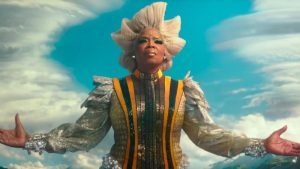Bits and Pieces 3/22/2018
I’ve been busy of late, and when prioritizing writing tasks, the blog generally finds itself low on the list. In addition to taking on duties in my neighborhood’s Homeowner’s Association (those jackboots won’t shine themselves), I’m working on a short story I was asked to write for a literary magazine, finishing up the critical second draft of The Holy Warrior and the Last Angel, laying the groundwork for a sequel to Appalling Stories (Appalling Stories 2: Even More Appalling Stories is the working title), and editing the digital magazine Creators Unite, a quarterly publication focusing on indie art, filmmaking, and publishing.
—
 Much has been made about Disney’s movie A Wrinkle in Time, based on Madeleine L’Engle’s novel. The film has received mediocre reviews which the director has attributed in part to racism instead of deliberate choices made in production that altered the story and themes. Rather than addressing teenage awkwardness and the difficulty of not fitting in with one’s peers, the filmmakers focused on racial diversity. They removed references to the Bible and Christianity in favor of feel-good spiritualism. There’s an emptiness behind the production that viewers understand, and the quality (and box office returns) suffers.
Much has been made about Disney’s movie A Wrinkle in Time, based on Madeleine L’Engle’s novel. The film has received mediocre reviews which the director has attributed in part to racism instead of deliberate choices made in production that altered the story and themes. Rather than addressing teenage awkwardness and the difficulty of not fitting in with one’s peers, the filmmakers focused on racial diversity. They removed references to the Bible and Christianity in favor of feel-good spiritualism. There’s an emptiness behind the production that viewers understand, and the quality (and box office returns) suffers.
I read the first three books of L’Engle’s Time Quintet in middle school, and enjoyed them quite a lot, so now, decades later, I’ve begun reading them again. The depiction of Mrs Who, Mrs Which, and Mrs Whatsit as angels, as former stars, is as affecting now as it was for me then. The bizarre mixture of science, faith, and fantasy works in a way few novels can hope to achieve. Thematically, A Wrinkle in Time deals with the concept of space, of distance, of love and acceptance. A Wind in the Door goes deeper, focusing on scale, on the connection of all things within God’s plan and how everything affects everything else. And A Swiftly Tilting Planet, which I’m about a third of the way through, clearly addresses time, of the past echoing into the future. These are thoughtful books, texts that both children and adults can appreciate. But, in many respects, they reflect the Cold War era in which they were written: the Earth is a dark place, filled with the likelihood of utter doom at any time. Nuclear war, inner city violence, environmental disaster, and societal decay eat at the periphery, and the entire planet is shadowed, fighting for its life against darkness.
It’s unfortunate that the filmmakers, in their desire to update the story according to Social Justice concerns, ruined what could have been a transcendent cinematic experience. Social Justice Warriors never create new things: they burrow into existing works, eviscerate them, and demand that you appreciate the mutilation they’ve inflicted. Anything less is racism. Sexism. Bigotry.
—
The Ritual is very much a movie made by horror fans for horror fans, and on that level I enjoyed it a great deal. There’s the protagonist haunted by a terrible past failing, the irritating character who gets even more irritating as the story progresses (so he survives longer than most of the characters), the gung-ho guy who dies first, and the likable fellow who lasts just long enough for you to feel bad about his horrible demise. It doesn’t break any new ground, but if you’re looking for a good old-fashioned wilderness horror film, The Ritual‘s your best bet.










